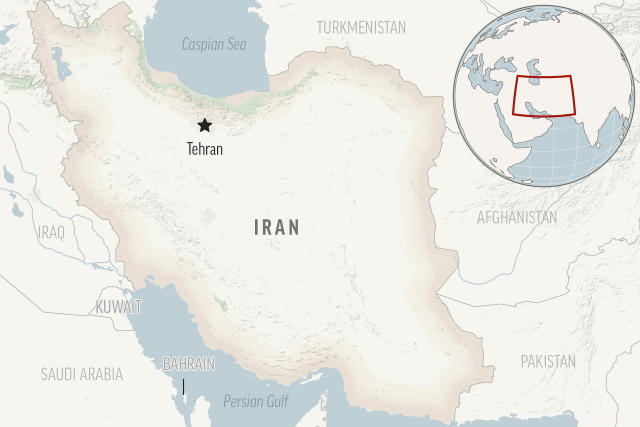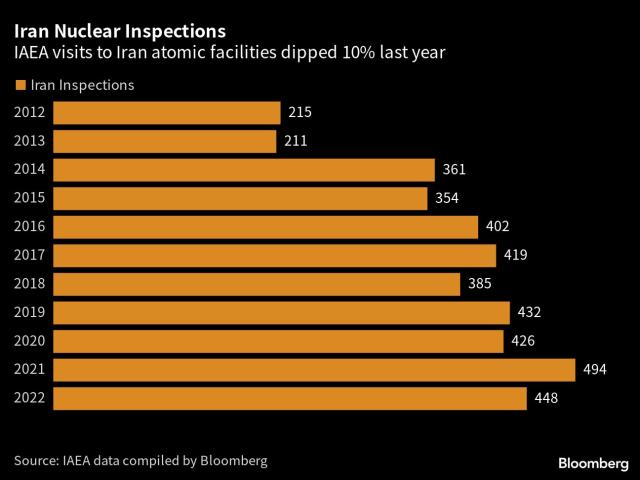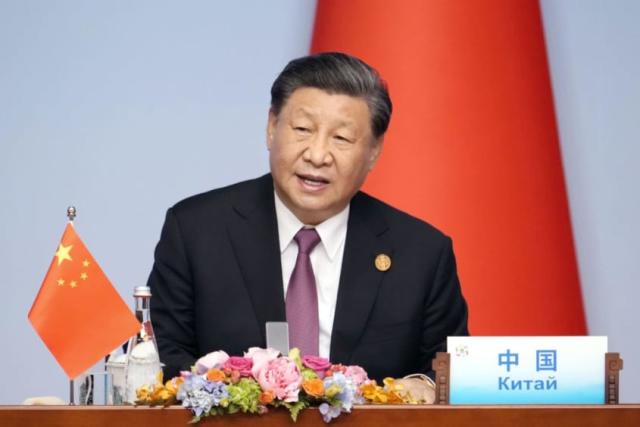World Geography And Politics Daily News | 01 Jun 2023

Views (143)

International Atomic Energy Agency reports seen by AP say Iran resolves 2 inquiries by inspectors
Iran has resolved two outstanding inquiries from the International Atomic Energy Agency over highly enriched uranium particles and a site where man-made uranium was found, according to confidential reports seen Wednesday by The Associated Press. The IAEA reports ease pressure slightly on Tehran, which has been escalating its program for years since the U.S. unilaterally withdrew from its nuclear deal with world powers in 2018. The two confidential quarterly reports by the Vienna-based IAEA, distributed to member states of the organization, said inspectors no longer had questions on uranium particles found to be enriched to 83.7% at its underground Fordo facility.

VIENNA (AP) — Iran has resolved two outstanding inquiries from the International Atomic Energy Agency over highly enriched uranium particles and a site where man-made uranium was found, according to confidential reports seen Wednesday by The Associated Press.
The IAEA reports ease pressure slightly on Tehran, which has been escalating its program for years since the U.S. unilaterally withdrew from its nuclear deal with world powers in 2018. However, it continues to amass more uranium nearer than ever to weapons-grade level, worrying nonproliferation experts.
The two confidential quarterly reports by the Vienna-based IAEA, distributed to member states of the organization, said inspectors no longer had questions on uranium particles found to be enriched to 83.7% at its underground Fordo facility. That had sparked tensions over the last several months as uranium enriched to 90% is weapons-grade material.
Iran had argued those particles were a byproduct of its current enrichment as particles can reach higher enrichment levels in fluctuations.
"The agency informed Iran that, following its evaluation of the data, the agency had assessed that the information provided was not inconsistent with Iran’s explanation ... and that the agency had no further questions on this matter at this stage,” the reports said.
The report said investigators also have closed off their investigation of traces of man-made uranium found at Marivan, near the city of Abadeh, some 525 kilometers (325 miles) southeast of Tehran.
Analysts had repeatedly linked Marivan to Iran’s secret military nuclear program and accused Iran of conducting high-explosives tests there in the early 2000s. The IAEA reports seen Wednesday also referenced that “Iran conducted explosive experiments with protective shielding in preparation for the use of neutron detectors and nuclear material” at the site.
The report said that “another member state” operated a mine at the area in the 1960s and 1970s under the rule of then-Shah Mohammad Reza Pahlavi. It wasn't immediately clear which nation was involved in the mining.
Iran had argued the uranium traces could have come from “laboratory instruments and equipment” used by miners at the site. The IAEA called the answer “a possible explanation.”
“The agency at this time has no additional questions on the depleted uranium particles detected at Marivan ... and the matter is no longer outstanding at this stage,” it said. The agency also installed enrichment monitoring devices at Fordo and Natanz, Iran's other main enrichment site, the report said.
Separately, the IAEA acknowledged installing new cameras at a workshops in the Iranian city of Isfahan where centrifuge rotors and bellows are manufactured. Centrifuges rapidly spin uranium gas, enriching it.
However, Iran has been withholding surveillance footage from the IAEA since February 2021 amid its tensions with the West, as well as removed cameras and other equipment. That raises the risk of Iran being able to have a covert enrichment program if it chose to do so.
The reports come as tensions between Iran and the West have escalated over its nuclear program. Tehran also has faced mass protests recently and anger from the West over it arming Russia with bomb-carrying drones now targeting Ukraine.
Iran’s 2015 nuclear deal limited Tehran’s uranium stockpile to 300 kilograms (661 pounds) and enrichment to 3.67% — enough to fuel a nuclear power plant. The U.S.′ unilateral withdrawal from the accord in 2018 set in motion a series of attacks and escalations by Tehran over its program.
Iran has been producing uranium enriched to 60% purity — a level for which nonproliferation experts already say Tehran has no civilian use. Iran maintains, however, that its program is for peaceful purposes. The IAEA, the West and other countries say Iran had a secret military nuclear program it abandoned in 2003.
The IAEA report also estimated that as of May 13, Iran’s total enriched uranium stockpile was at 4,744.5 kilograms (10,460 pounds). Of that, 114.1 kilograms (251 pounds) is enriched up to 60% purity, a short, technical step to weapons-grade levels.
The last IAEA estimate in February put Iran’s uranium stockpile at some 3,760 kilograms (8,289 pounds). Of that, 87.5 kilograms (192 pounds) was enriched up to 60% purity.
In a statement, the U.S. State Department said it had “full confidence” in the IAEA and that President Joe Biden was “absolutely committed to never allowing Iran to acquire a nuclear weapon.”
“We appreciate the IAEA’s extensive efforts to engage Iran on longstanding questions related to Iran’s safeguards obligations,” the State Department said. “We have made clear that Iran must fully uphold its safeguards obligations.”
___
Associated Press writers Jon Gambrell in Dubai, United Arab Emirates, and Matthew Lee in Oslo, Norway, contributed to this report.
Iran Steps Up IAEA Cooperation Even as Uranium Stockpile Surges
(Bloomberg) -- Iran has re-installed monitoring equipment and boosted its cooperation with international inspectors even as its engineers added to stockpiles of uranium enriched closer to weapons grade, the global nuclear watchdog reported Wednesday. Most Read from BloombergChina Is Drilling a 10,000-Meter-Deep Hole Into Earth’s CrustS&P 500 Almost Wipes Out Its Monthly Advance: Markets WrapHedge Funds Are Deploying ChatGPT to Handle All the Grunt WorkTwitter Is Now Worth Just 33% of Elon Musk’s

(Bloomberg) -- Iran has re-installed monitoring equipment and boosted its cooperation with international inspectors even as its engineers added to stockpiles of uranium enriched closer to weapons grade, the global nuclear watchdog reported Wednesday.
Most Read from Bloomberg
The findings published in the International Atomic Energy Agency’s quarterly report on Iran reduces the likelihood that the Islamic Republic will face censure when diplomats convene June 6 to discuss its nuclear program.
IAEA inspectors had raised concerns in March over the presence of uranium particles enriched to 84% levels of purity and chided Iran’s slow response to separate investigations, raising the prospect of worsening tensions in the Middle East.
On Wednesday, agency inspectors wrote they “had no further questions” about the presence of those highly-enriched particles and accepted Iran’s explanation.
Iran is already at the center of several overlapping geopolitical crises, including the effective suspension of its nuclear talks with world powers, its military support for Russia’s war on Ukraine and the recent seizure of ships near the narrow entrance to the Persian Gulf.
“Some progress has been made,” IAEA Director General Rafael Mariano Grossi wrote in one of two restricted reports published Wednesday. “Iran has provided a possible explanation for the presence of depleted uranium particles. Iran has allowed the agency to install some additional surveillance cameras”
Without Nuclear Deal, How Close Is Iran to a Bomb?: QuickTake
Iran’s stockpile of uranium enriched to 60% levels of purity reached 114.1 kilograms (251.6 pounds) a significant increase from the 87.5 kilograms documented in the last report at the end of February. Inventories of 20%-enriched fuel grew to 470.9 kilograms from 435 kilograms.
It’s the tenth consecutive quarter that Iran has added to its reserve of nuclear fuel enriched to 60%, despite suffocating US sanctions. That purity is still below the 90% grade typically used for weapons, but much higher than the 300 kilograms at 3.67% purity cap set by the now-defunct nuclear accord.
Iran’s Uranium Enrichment Hits a New High, Testing Diplomacy
While Iran has always maintained its atomic work is peaceful, world powers negotiated the nuclear pact with the Persian Gulf nation in 2015 because they doubted that claim.
The so-called JCPOA limited Iran’s nuclear activities and imposed unprecedented monitoring in return for sanctions relief. But the Trump administration withdrew from the deal in 2018, reimposing sanctions and prompting Iran to cease compliance. Diplomats have subsequently failed to restore its provisions.
Iran’s re-installation of monitoring equipment is significant because it will help preserve data IAEA monitors need to reconstruct certain nuclear activities, should another agreement with world powers be struck. The prolonged absence of monitoring at some Iranian sites means inspectors will have to start from square one in reconstructing knowledge.
“The agency would not be able to re-establish continuity of knowledge in relation to the production and inventory of centrifuges,” read the report. “Instead, the agency would need to establish a new baseline.”
IAEA inspections of Iran fell about 10% last year but remained well above monitoring levels before the 2015 nuclear agreement, a separate report circulated among diplomats earlier this month found.
Most Read from Bloomberg Businessweek
©2023 Bloomberg L.P.
Xi Jinping tells national security team to prepare for 'worst-case scenario'
Xi Jinping tells national security team to prepare for 'worst-case scenario'

Chinese President Xi Jinping told his national security team Tuesday that they should prepare for a "worst-case scenario," saying that internal and external threats to the country had increased.
South Africa looks to grant Putin diplomatic immunity for BRICS summit despite outstanding ICC arrest warrant
South Africa is looking for loopholes in the International Criminal Court's charter that may allow Russian President Putin to attend the BRICS summit in August.

Theoretically, any ICC member nation Putin travels to would be compelled to seize the Kremlin chief, though South Africa is apparently willing to skirt its international obligations, according to Russian press secretary Dmitry Peskov.
"Russia attaches enormous importance to the development of this format of integration. And Russia will take part in this summit at the proper level," he said during a Tuesday press conference. "Of course we count as a bare minimum on partner countries in such an important format not being guided by such illegal decisions."
Though Monyela also added that "these immunities do not override any warrant that may have been issued by any international tribunal against any attendee of the conference."
It remains unclear if Putin will actually be able to attend the summit set for later this summer, though South Africa has reportedly been looking into the wording of the Rome Statute – the ICC’s establishing charter – for any loopholes that would allow Putin to visit South Africa without the necessity to then arrest him.
In April, South African President Cyril Ramaphosa established an inter-ministerial committee to look into the language of the statute and how it must be applied.
Reports surfaced in late April suggesting that South Africa was considering leaving the ICC after the international court issued the arrest warrant for Putin, though Ramaphosa immediately walked back this threat, calling it an "error in a comment" made by his ruling party.
"South Africa remains a signatory to the Rome Statute and will continue to campaign for equal and consistent application of international law," he said in a statement on April 25.
Reuters contributed to this report.
Putin says drone attacks on Moscow are attempt by Ukraine 'to intimidate Russia'
A drone attack targeting Moscow was an attempt by Ukraine “to intimidate Russia, Russian citizens and attacks on residential buildings," Putin says.

The remarks come after eight drones targeted Russia’s capital early Tuesday before being shot down or diverted with electronic jammers. Moscow Mayor Sergei Sobyanin said the attack caused "insignificant damage" to several buildings and that two people received treatment for unspecified injuries but did not need hospitalization. Residents of two high-rise buildings damaged in the attack were evacuated.
"This is clearly a sign of terrorist activity," Putin said Tuesday, adding that Ukraine has chosen a path of trying "to intimidate Russia, Russian citizens and attacks on residential buildings".
Putin said Moscow's air defense "worked in a satisfactory way" but added it was "clear what we need to do to plug the gaps" in the system, The Associated Press reported.
Andrei Vorobyov, governor of the wider Moscow region, said a few of the drones in Tuesday’s incident were "shot down on the approach to Moscow."
Ukrainian military analysts, though unable to confirm Kyiv had launched the drones against Moscow, told the AP the attack may have involved UJ-22 drones, which are produced in Ukraine and have a maximum range of about 620 miles.
Some of the drone debris hit an area of western Moscow where Putin has a residence, according to Reuters.
Residents in Moscow also reported hearing loud bangs followed by the smell of fuel, the news agency added.
In that attack, at least 20 Shahed explosive drones were struck down by air defense forces in Kyiv’s airspace, according to the Kyiv Military Administration via The Associated Press.
One person was reported killed and seven were injured.
A high-rise building in the Holosiiv district caught fire after being hit by debris from drones or interceptor missiles, the Kyiv Military Administration reported. The building’s upper two floors were destroyed, causing over 20 people to be evacuated and raising concerns that more could be trapped under the rubble.
Falling debris also caused a fire in a private house in the Darnytskyi district and three cars were set ablaze in the Pechersky district, according to the military administration.
Fox News’ Landon Mion and the Associated Press contributed to this report.
North Korea Attempts to Launch Satellite But It Crashes Into Ocean
I Spy North Korea was trying its very best to send a spy satellite up into space — but that thing just didn't want to stay in the sky. As North Korea's Korean Central News Agency reported, the failed Malligyong-1 satellite, which was launched on a Chollima-1 rocket, experienced a second-stage malfunction that saw it […]

North Korea was trying its very best to send a spy satellite up into space — but it just didn't want to stay in the sky.
The Pyongyang-run media attributed the satellite's failure to "unstable" fuel and the newness of the Chollima-1 rocket, and has vowed to fix its "serious defects" and relaunch as soon as possible.
South Korea later revealed that it had salvaged part of what is believed to be the wreckage, which could be a huge boon for the country.
As with all statecraft, this debacle has many layers, and although it's scary to imagine North Korea trying to get around the rules preventing it from testing long-range missiles, it's at least reassuring that its latest attempt crashed and burned.
0 Likes
